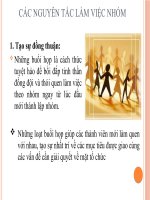Kĩ năng làm việc nhóm Team and teamwork
Bạn đang xem bản rút gọn của tài liệu. Xem và tải ngay bản đầy đủ của tài liệu tại đây (195.03 KB, 34 trang )
Chapter 9: Teams and Teamwork
PSYC 352
Terminology
Dyad: Two-person unit
Group vs. Team
No real distinction
Team: A social aggregation in which a limited number
of individuals interact on a regular basis to accomplish a
set of shared objectives for which they have mutual
responsibility.
Origins of Work Teams
Factors that led to the use of teams:
Information age
Educated and trained population
Rate of change in work activities
Teams are not always better than individuals
Level of Analysis
Individual vs. Team vs. Organization
Micro vs. Meso vs. Macro
Organization
Work Groups
Individuals
Types of Teams
(Larson & LaFasto, 1989)
Problem Solving Team: A type of team
created for the purpose of focusing on the
resolution of a particular problem or issue.
Creative Team: A type of team created for
the purpose of developing innovative
possibilities or solutions.
Types of Teams
(Larson & LaFasto, 1989)
Tactical Team: A type of team created for
the purpose of executing a well-defined plan
or objective.
Ad Hoc Team: A type of team created for a
limited duration that is designed to address
itself to resolving one particular problem.
Types of Teams
(Larson & LaFasto, 1989)
Broad
Objective
Dominant
Feature
Problem
Trust
Resolution
Process Emphasis
Focus on Issues
Example
CDC
Creative
Autonomy Explore possibilities and
alternatives
IBM PC
Team
Tactical
Clarity
Cardiac
Surgery
Team
Directive, highly focused
tasks, role clarity, welldefined operational
standards, accuracy
Principles of Teamwork
1.
2.
3.
4.
5.
Feedback provided and accepted
Backing up team members
Collective group
Within-team interdependence
Leadership makes a difference
Team Structure
Structure of a team includes:
Number of members
Demographic composition
Experience of members
Diversity in teams:
Information diversity
Value diversity
Team Processes:
Stages of Development
Forming
Norming
Performing
Storming
Adjourning
Team Structure: Roles
Diversity within a team is
reflected in the members
filling different roles.
L
e
d
ea
ip
h
rs
Leader
Effective teams are
Shaper
composed of members
Worker
who serve different roles
Completeron the team and their roles W
Finisher
or
are defined by possession
k
Pr Creator
of selected mental abilities
od
uc
and personality
er
characteristics.
Li
ais
on
Resource
investigator
Team
Facilitator
Monitorevaluator
e
c
m an
a
Tenten
ai
M Belbin, 1981
Team Processes: Socialization
Socialization: process of mutual adjustment
that produces changes over time in the
relationship between a person and a team.
How socialization works (Moreland & Levine, 2001):
Evaluation
Commitment
Role transition and phases of membership
(investigation, socialization, maintenance,
resocialization, remembrance)
Team Processes:
Interpersonal Processes
Communication
Conflict
Cohesion
Trust
Team Processes:
Shared Mental Models
Shared Mental Model:the cognitive
processes held in common by members of a
team regarding how they acquire
information, analyze it, and respond to it.
What is shared (Cannon-Bowers & Salas, 2001)?
Task-specific knowledge
Task-related knowledge
Knowledge of teammates
Shared attitudes and beliefs
Team Processes:
Shared Mental Models
Groupthink:a phenomenon associated with
team decision making in which members feel
threatened by forces external to the team,
resulting in a deterioration in the cognitive
processing of information.
3 Causes:
High level of cohesion
Structural organizational flaw
Proactive situational context
Groupthink Example
A board of directors of an international air
freight service must decide whether the
company should enter a cost-cutting war with
their competitors. The board begins its
decision-making meeting with the
chairperson’s loaded questions: “Should we
enter into this foolish price war or just keep
rates the way they are?”
Team Processes:
Decision Making
Multi-level theory of team decision
making (Hollenbeck, LePine, & Ilgen,
1996):
Team informity
Staff validity
Dyadic sensitivity
Improving Team Decision
Making
Assign the devil’s advocate role
Be open to dissenting points of view
Seek outside opinions
Break up into smaller groups
Rethink issues before making final decision
Use brainstorming
Virtual Teams
Virtual teams: Task-focused teams that meet
without being physically present or working
at the same time.
Defining Characteristics (Avolio et al., 2001):
Communication takes place electronically
Team members are dispersed geographically
Members may interact synchronously or
asynchronously
Virtual Teams
Challenges:
Development of shared mental models
Evaluation of team results
Achievement of team cohesion
Problems with leadership
Intergroup Conflict
Causes:
Lack of resources
Goal incompatibility
Time compatibility
Influence tactics
Intergroup Conflict
Consequences:
Conflict changes group members’ perceptions of
each other
Group becomes more cohesive
Strained interaction between the two groups
Argumentative behavior
Attitudes passed on to new members
Goals focus inward, away from organization as a
whole
Overcoming Intergroup
Conflict
Superordinate Goals: goals that both groups
endorse and that often require cooperative
intergroup behavior to be achieved
Getting 2 conflicting groups together by itself
will not reduce conflict
Conflict can be reduced if members cooperate to
achieve superordinate goals.
Overcoming Intergroup
Conflict
One problem occurs in conflicting groups is
that they do not communicate.
One strategy to overcome the conflict is to
plan a negotiation between the 2 groups.
Negotiation:facilitates communication and is
usually seen a a fair method of dispute
resolution.
Overcoming Intergroup
Conflict
Member exchanges: members of conflicting
groups role play each other.
Intergroup team development: team
activities to improve relationships between
groups.









